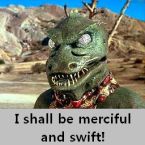DHRedge
Posts: 191
Joined: 1/18/2010
Status: offline

|
I played the board game when 9 to 12 years old, however I could not find an opponent after a few months of other people not wanting to study the rules, so when I saw it was a computer game, I started playing it.
I learned the computer part by replaying the first couple months many times to learn the different functionality.
took a few months to be comfortable with the tactics, and still have not learned the intricacies of all the different combinations of units and capabilities.
And I read the forms looking for obscure tips and nuggets that add to understanding of the mechanics.
Although the way I learn best is visual, not flashy graphics, but information containing content in graphics.
What I would really like to do is get my hands on the code base and start toying around with some AI ideas, and some GUI ideas
I really like visual indicators of actions, with colors shapes and location, and think something could be added to the ship to ship and air to air display to migrate the information in the text into visual forms. So the ship combat, having a way to see the weapon loads fired from the ship locations, like how numbers float upwards in some games, to indicate weapon usage, and damage. And with persistence, (since as numbers drift you can see them longer), and can see how much damage or what weapon hit/fired while looking at the ship icon.
Simple ideas like floating indicator of weapon fired type, and thickness as ammo load left, and floating location could determine what weapon. Then there is the idea of looking at facing to indicate if broadsiding or front/rear firing, although that could be battle AI code with a hud showing ship config. Stuff like that. That is how I usually learn, looking for details from indicators. Currently it is difficult to watch the 'ship fired' 'ship effected' icon while also reading the text. And air bombardment is all about reading text to see effects, seems a GUI could be developed to put that into a visual context.
Something as simple as text color in air combat showing what side is firing is an easy way to add information very intuitively.
Stuff like that.
Because I learn the game, by trying to get as much possible out of the output in battles, to try and see what is advantages, so it would be a challenge to find ways to add to the GUI that would add information to the users (with on off switches to avoid information overload)
And Ai ideas, something as simple as dividing the ocean into (20 to 50 hex) sectors, then having that part of planing, could add much to different directions of attacks, variety of path of travel, and coordination for AI. Plan movement, first start to finish, then by pathing sectors, then pathing within each sector,. So there would be a few sectors on each axis of Midway, and the sector picked would be the attack vector, and paths would be more varied from going from sector to sector(if still shortest, or for better variety, within some tolerance, and sectors would have the 'danger' values, not hexes, so pathing dangers does not indicate some location of some sub or TF( hot, mixed, or safe danger in a sector from air contact for pathing for instance)
And more confined areas, like coral sea, or near Phillapeans, would have smaller sectors, open ocean could be larger sectors. Then the complex ai decisions could be done much more about sector, and much more processing, then another stage would do the fine detail of exact hexes to move through in a sector. Computing with 10000s of hexes, takes much longer then computing 100 sectors with 20 hexes each.
Sectors of coarse would only be for AI to understand an 'area' and its value, and would also add to things like 'landing next to a city' since 'getting close' by 'anywhere in sector', would be part of the planing, then a short march of hex or two across land, or from one city to another. So China would have port Arthur land sector, and Singapore sector, and Hong Kong sector, and many other sectors, maybe even as small as 4 or 5 hexes sometimes, and planing would be first done by looking at top level 'drive directions' then 'sectors' as objectives, then targets in objectives'. Tables of better and worse ways to move between sectors, values, and various other hardcoded information, could be combined with 'dynamic changes of LCUs or ships' to then determine plans for battles or scripting choices.
One script could say attack Phillapeans south, but could then choose what hex in that sector it targets, making that script 5 to 10 times more variable, and more dynamic by looking at dynamic changes in defenses and LCUs at location for landing, but easy since computer only deciding between a few hexes once sector decided. And all the sector info would be read in from files, as would scripting, so it could be modifiable without code changes.
That kind of stuff.
Anyways I am rambling a bit, but that is how I think on processes, finding some sector, learning it, then looking more in detail later. So I learn pilots, then later the intricacies of training on a second or third pass of playing the game.
I learn air missions first try of game, then combining cap from multiple bases second try, then altitudes ideas on third game. each game being a few weeks of play from start, to learn the mechanics of game.
Bob Eastwood
Edit, and sectors could overlap
The main part is decisions thinking in ideas of moving to a sector, then from that, how to best function within that sector, and when sectors need things like front lines or garrisons from threat assessments. And open areas around cities could be part of more then one sector. And also to compute weakness in nearby sectors, then looking at exploitable avenues in those sectors, including various things like difficulty of combat from one sector to another, where sectors contain or are created by river lines as an example. Or ideas where an approach is unlikely by expanse of jungle as the sector near by, or difficult terrain to move in without roads.
In ocean hexes, a sector with 'air search' would have its dynamic safety improved, so that nearby land sectors would be less worried about landings(setting of naval patrols, air attacks). And if a sector has a 'contact' of some taskforce, nearby sectors would have a higher alert status to search and naval attack at, or to reroute convoys if friendly convoys nearby.
Near by sectors with active air bases would also indicate higher indication of possible threats, again as an example.
There is an old Sim City bit of coding, a refrigerator would broadcast its status of 'having food', in a similar way, a sector would broadcast its status to other sectors so AI would be aware of threat assessment and best targeting.
So South Phillapean Sector, if anphib ships are detected a couple sectors away, S. Phil sector would have a warning broadcast to it, that would be in an info array it would use while deciding its 'best use of air missions', and possible repositioning of units, or request for naval cover.
If another nearby sector had an airbase, it would broadcast that threat to each sector around it, including S. Phil so they would know of that threat. Then each sector would compute its request for resources, and decide how to use those resources.(air naval and ground) Could also help ports get ships out of port if new threats appear nearby, or help ground units move to areas where there are battles.
Probably would be a large change but it would be interesting way to code some AI into reacting to dynamic changes in situations.
< Message edited by DHRedge -- 6/20/2013 3:02:44 AM >
|
 Printable Version
Printable Version












 As for this game, I started in 2010 for the first time, played Coral Sea a number of times and then jumped into a campaign scenario playing against the AI. I was too impatient to read the manual and just figured it out as I went along. I went all the way to March of '46. I didn't use the A-bomb because that wouldn't be any fun. I cleared all of the Phillipines, the DEI and all of Asia of Japanese troops (with Soviet help of course). I blocked them from getting any more than one hex of Korea by using paratroops. I built Korea up into a massive airbase large enough to accomadate the entire US Army Air Force. I did use firebombing alot to reduce manpower and otherwise degrade factories, just once at each site though and followed up with conventional bombing. I had just captured Kyushu (the first aquisition of Japanese territory, I skipped Okinawa) when the game ended. Now I've got two PBEM campaigns under my belt and have one in progress now. It's time for me to learn how to play the Japanese. I have yet to lose a CV or a CVL or CVE against a human opponent, knock on wood.
As for this game, I started in 2010 for the first time, played Coral Sea a number of times and then jumped into a campaign scenario playing against the AI. I was too impatient to read the manual and just figured it out as I went along. I went all the way to March of '46. I didn't use the A-bomb because that wouldn't be any fun. I cleared all of the Phillipines, the DEI and all of Asia of Japanese troops (with Soviet help of course). I blocked them from getting any more than one hex of Korea by using paratroops. I built Korea up into a massive airbase large enough to accomadate the entire US Army Air Force. I did use firebombing alot to reduce manpower and otherwise degrade factories, just once at each site though and followed up with conventional bombing. I had just captured Kyushu (the first aquisition of Japanese territory, I skipped Okinawa) when the game ended. Now I've got two PBEM campaigns under my belt and have one in progress now. It's time for me to learn how to play the Japanese. I have yet to lose a CV or a CVL or CVE against a human opponent, knock on wood.


 New Messages
New Messages No New Messages
No New Messages Hot Topic w/ New Messages
Hot Topic w/ New Messages Hot Topic w/o New Messages
Hot Topic w/o New Messages Locked w/ New Messages
Locked w/ New Messages Locked w/o New Messages
Locked w/o New Messages Post New Thread
Post New Thread